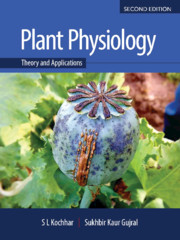Book contents
- Frontmatter
- Contents
- Foreword
- Preface to the Second Edition
- Preface to the First Edition
- Acknowledgements
- Some Common Abbreviations used in the Text
- Abbreviations for Units
- Unit I Water and Mineral Translocation in Plants
- Unit II Metabolism and Bioenergetics
- Unit III Growth and Development
- Unit IV Physiological Stress and Secondary Metabolites – Their Role in Metabolism
- Unit V Crop Physiology – An Innovative Approach
- Unit VI Breakthroughs in Plant Physiology
- Unit VII Some Experimental Exercises
- Glossary
- References
- Index
- Colour Plates
Chapter 18 - Abiotic and Biotic Stress
Published online by Cambridge University Press: 12 May 2020
- Frontmatter
- Contents
- Foreword
- Preface to the Second Edition
- Preface to the First Edition
- Acknowledgements
- Some Common Abbreviations used in the Text
- Abbreviations for Units
- Unit I Water and Mineral Translocation in Plants
- Unit II Metabolism and Bioenergetics
- Unit III Growth and Development
- Unit IV Physiological Stress and Secondary Metabolites – Their Role in Metabolism
- Unit V Crop Physiology – An Innovative Approach
- Unit VI Breakthroughs in Plant Physiology
- Unit VII Some Experimental Exercises
- Glossary
- References
- Index
- Colour Plates
Summary
Under both natural and agricultural situations, plants are often subjected to environmental stresses. Stress plays an important role in determining how soil and climate restrict the distribution of plant species. Stress is usually defined as a disadvantageous impact on the physiology of a plant, induced upon a sudden shift from optimal environmental condition where homeostasis is maintained to suboptimal level which disturbs the initial homeostatic state. In most cases, stress is measured in terms of plant survival, crop productivity or the primary assimilation processes, which are all co-related to overall growth.
Plant stress can be divided into two categories: Abiotic and Biotic.
Abiotic Stress
Plants grow and reproduce in hostile environments containing large numbers of abiotic chemical and physical variables, which differ both with time and geographical location. The primary abiotic environmental parameters that affect plant growth are light, water, carbon dioxide, oxygen, soil nutrient content and availability, temperature, salts, and heavy metals. Fluctuations of these abiotic factors generally have negative biochemical and physiological impact on plants. Being fixed, plants are unable to avoid abiotic stress by simply moving to a more suitable environment. Instead, plants have evolved the ability to compensate for stressful conditions by switching over physiological and developmental processes to maintain growth and reproduction.
Responses to abiotic stress depend on the extremity and time duration of the stress, developmental stage, tissue type and interactions between multiple stresses (Figure 18.1). Experiencing stress typically promotes alterations in gene expression and metabolism, and reactions are frequently centred on altered patterns of secondary metabolites. Plants are complex biological systems comprising of thousands of different genes, proteins, regulatory molecules, signalling agents, and chemical compounds that form hundreds of interlinked pathways and networks. Under normal growing conditions, the different biochemical pathways and signalling networks must act in a coordinated manner to balance environmental inputs with the plant's genetic imperative to grow and reproduce. When exposed to unfavourable environmental conditions, this complex interactive system adjusts homeostatically to minimize the negative impacts of stress and maintain metabolic equilibrium.
- Type
- Chapter
- Information
- Plant PhysiologyTheory and Applications, pp. 545 - 589Publisher: Cambridge University PressPrint publication year: 2020



